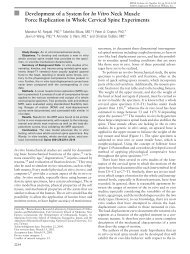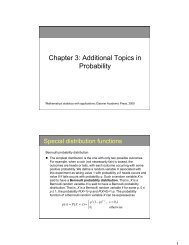anatomical reduction is not necessary in treating non-porotic ...
anatomical reduction is not necessary in treating non-porotic ...
anatomical reduction is not necessary in treating non-porotic ...
Create successful ePaper yourself
Turn your PDF publications into a flip-book with our unique Google optimized e-Paper software.
ANATOMICAL REDUCTION IS NOT NECESSARY<br />
IN TREATING NON-POROTIC UNSTABLE<br />
INTERTROCHANTERIC FRACTURE – A<br />
BIOMECHANICAL STUDY OF PORCINE MODEL<br />
ABSTRACT<br />
Shi-Wei L<strong>in</strong>, Jaw-L<strong>in</strong> Wang<br />
Institute of Biomedical Eng<strong>in</strong>eer<strong>in</strong>g<br />
National Taiwan University<br />
Taipei, Taiwan, ROC<br />
Proceed<strong>in</strong>gs of IMECE’03<br />
2003 ASME International Mechanical Eng<strong>in</strong>eer<strong>in</strong>g Congress & Exposition<br />
Wash<strong>in</strong>gton, D.C., November 16-21, 2003<br />
IMECE2003-42910<br />
fragment was prepared us<strong>in</strong>g surgical saw (Figure 1). The fracture<br />
was reconstructed by a compression hip screw, and the <strong>anatomical</strong><br />
<strong>reduction</strong> was achieved with a cerclage wir<strong>in</strong>g (Figure 2A), and<br />
without cerclage wir<strong>in</strong>g (Figure 2B). A static force-controlled load<br />
was gradually applied to the femoral head up to 700 N to simulate<br />
post-operative weight bear<strong>in</strong>g condition for both surgical techniques.<br />
The d<strong>is</strong>placement, stra<strong>in</strong> at tube plate and femur were recorded for<br />
analys<strong>is</strong>. The stiffness of femur complex, stra<strong>in</strong> at tube plate per load,<br />
and stra<strong>in</strong> at medial side of femur per load were calculated for analys<strong>is</strong>.<br />
Two-way analys<strong>is</strong> of variance (ANOVA) was used for the above three<br />
parameters to determ<strong>in</strong>e the differences of different cerclage wir<strong>in</strong>g<br />
techniques.<br />
Intertrochanteric fracture occurred more than 200,000 cases each year<br />
<strong>in</strong> the United States, with mortality rate up to 20 percents. Evans<br />
classified the <strong>in</strong>tertrochanteric fracture pattern to stable and unstable<br />
group. Most of the complications occurred <strong>in</strong> the unstable group. It <strong>is</strong><br />
speculated that <strong>in</strong> the unstable <strong>in</strong>tertrochanteric fracture, the lag screw<br />
migrates easily <strong>in</strong>to the <strong>porotic</strong> femur head and than caus<strong>in</strong>g fixation<br />
failure. So the treatment of <strong>porotic</strong> unstable femoral <strong>in</strong>tertrochanteric<br />
fracture depends on the bone quality, severity of comm<strong>in</strong>ution,<br />
<strong>anatomical</strong> <strong>reduction</strong> and methods of fixation. An abundant of studies<br />
had been focused on how to re<strong>in</strong>force the <strong>porotic</strong> unstable<br />
<strong>in</strong>tertrochanteric fracture <strong>in</strong>clud<strong>in</strong>g osteotomies, cement augmentation,<br />
<strong>anatomical</strong> <strong>reduction</strong>, and different implant applications. Among the<br />
many techniques, the <strong>anatomical</strong> <strong>reduction</strong> us<strong>in</strong>g cerclage wir<strong>in</strong>g was<br />
widely used to enhance the stability of osteo<strong>porotic</strong> fractured femur.<br />
However, <strong>in</strong> the young adult, the application of cerclage wir<strong>in</strong>g <strong>is</strong><br />
controversial. The current study compares the mechanical properties<br />
of two <strong>anatomical</strong> <strong>reduction</strong> techniques of unstable <strong>in</strong>tertrochanteric<br />
fracture reconstructed by a compression hip screw. Four porc<strong>in</strong>e<br />
femurs of 10 months-old were used to simulate the <strong>non</strong>-<strong>porotic</strong> human<br />
bone. The specimens were stripped of all soft t<strong>is</strong>sues. Each femur<br />
was prepared with four holes for dynamic hip screws follow<strong>in</strong>g the<br />
standard surgical procedure. The <strong>anatomical</strong> <strong>reduction</strong> was achieved<br />
by a cerclage wir<strong>in</strong>g and without cerclage wir<strong>in</strong>g. The results reveal<br />
that <strong>in</strong> the <strong>non</strong>-<strong>porotic</strong> porc<strong>in</strong>e model, there <strong>is</strong> no stat<strong>is</strong>tically<br />
difference <strong>in</strong> stiffness, plate stra<strong>in</strong> and medial bone stra<strong>in</strong> per load. No<br />
matter the unstable <strong>in</strong>tertrochanteric fracture <strong>is</strong> reduced with cerclage<br />
wire or <strong>not</strong>. The <strong>non</strong>-<strong>porotic</strong> unstable <strong>in</strong>tertrochanteric fracture<br />
<strong>anatomical</strong> <strong>reduction</strong> <strong>is</strong> <strong>not</strong> <strong>necessary</strong> if protective weight bear<strong>in</strong>g <strong>is</strong><br />
obeyed. However, whether the cerclage wir<strong>in</strong>g <strong>is</strong> <strong>necessary</strong> or <strong>not</strong> for<br />
the osteo<strong>porotic</strong> unstable femur fracture needs further study.<br />
Fracture L<strong>in</strong>e<br />
Stra<strong>in</strong> Gage<br />
Fracture L<strong>in</strong>e<br />
Stra<strong>in</strong> Gage<br />
Figure 1. An artificial Evans Type-3 <strong>in</strong>tertrochanteric<br />
fracture with a posterior medial bony fragment.<br />
MATERIAL AND METHODS<br />
Four porc<strong>in</strong>e femurs of 10 months-old were used to simulate the <strong>non</strong><strong>porotic</strong><br />
human bone. The specimens were stripped of all soft t<strong>is</strong>sues.<br />
Each femur was prepared with four holes for dynamic hip screws<br />
follow<strong>in</strong>g the standard surgical procedure. The position of lag screw<br />
tip was <strong>in</strong> the center of femoral head with 5 mm d<strong>is</strong>tance to the<br />
subcondral bone <strong>in</strong> both AP and lateral view. All positions of<br />
<strong>in</strong>sertion were confirmed with radiography. The femur was potted with<br />
epoxy and aligned at 25 degree adduction <strong>in</strong> the coronal plane and<br />
neutral <strong>in</strong> the sagittal plane to simulate the leg stance. One stra<strong>in</strong> gauge<br />
was applied on the lateral side of tube plate close to the first screw<br />
hole. The second stra<strong>in</strong> gauge was applied on the medial side of the<br />
femur 2 cm beneath the lesser trochanter (Figure 1). An artificial<br />
Evans Type-3 <strong>in</strong>tertrochanteric fracture with a posterior medial bony<br />
(A)<br />
Figure 2. The unstable <strong>in</strong>tertrochanteric fracture was<br />
reconstructed by a compression hip screw, and the<br />
<strong>anatomical</strong> <strong>reduction</strong> was achieved with (A) cerclage wir<strong>in</strong>g,<br />
and (B) without cerclage wir<strong>in</strong>g.<br />
(B)<br />
1<br />
Copyright ©2003 by ASME
RESULTS<br />
The results l<strong>is</strong>ted <strong>in</strong> Table 1 revealed that <strong>in</strong> the <strong>non</strong>-<strong>porotic</strong> porc<strong>in</strong>e<br />
model, there <strong>is</strong> no stat<strong>is</strong>tically difference <strong>in</strong> stiffness, plate stra<strong>in</strong> and<br />
medial bone stra<strong>in</strong> per load. No matter the unstable <strong>in</strong>tertrochanteric<br />
fracture <strong>is</strong> reduced with cerclage wire or <strong>not</strong>.<br />
Table 1: The compar<strong>is</strong>on of mechanical properties of<br />
unstable <strong>in</strong>tertrochanteric fracture constructed by a<br />
compression hip screw with and without the cerclage<br />
wir<strong>in</strong>g<br />
Stiffness<br />
(N/mm)<br />
Lateral Plate Stra<strong>in</strong><br />
per Force<br />
(micro stra<strong>in</strong>/N)<br />
Medial Bone Stra<strong>in</strong><br />
per Force<br />
(micro stra<strong>in</strong>/N)<br />
With Wir<strong>in</strong>g 238 (90) 0.024 (0.507) 0.352 (0.506)<br />
Without Wir<strong>in</strong>g 269 (113) 0.047 (0.564) 0.392 (0.405)<br />
p-value 0.685 0.953 0.905<br />
DISCUSSION<br />
Despite the massive effort <strong>in</strong> solv<strong>in</strong>g the high complication rate <strong>in</strong> the<br />
osteo<strong>porotic</strong> unstable <strong>in</strong>tertrochanteric fracture surgery, the<br />
complications are still observed such as head varus deformity, lag<br />
screw migration <strong>in</strong> the head and even the lag screw cut out of the<br />
femur head. Instead of traditional failure test<strong>in</strong>g which <strong>is</strong> <strong>not</strong><br />
reasonable <strong>in</strong> cl<strong>in</strong>ical condition, the current study limited the<br />
maximum load<strong>in</strong>g to 700 N to mimic the post-operative protective<br />
weight bear<strong>in</strong>g. In our <strong>non</strong>-<strong>porotic</strong> bone-implant test<strong>in</strong>g, we can<strong>not</strong><br />
see if there <strong>is</strong> any stat<strong>is</strong>tically significant difference for stiffness and<br />
stra<strong>in</strong> at plate and bone between two different cerclage wir<strong>in</strong>g<br />
techniques. The reason may be due to the good quality of bone<br />
strength that makes the purchas<strong>in</strong>g strength of lag screw strong enough<br />
to support the load<strong>in</strong>g <strong>in</strong> the range of protected weight bear<strong>in</strong>g. Hence<br />
the further <strong>anatomical</strong> <strong>reduction</strong> <strong>is</strong> <strong>not</strong> <strong>necessary</strong>. In conclusion, the<br />
<strong>non</strong>-<strong>porotic</strong> unstable <strong>in</strong>tertrochanteric fracture <strong>anatomical</strong> <strong>reduction</strong> <strong>is</strong><br />
<strong>not</strong> <strong>necessary</strong> if protective weight bear<strong>in</strong>g <strong>is</strong> obeyed. However,<br />
whether the cerclage wir<strong>in</strong>g <strong>is</strong> <strong>necessary</strong> or <strong>not</strong> for the osteo<strong>porotic</strong><br />
unstable femur fracture needs further study.<br />
ACKNOWLEDGEMENTS<br />
Th<strong>is</strong> study was supported by National Science Council, ROC (NSC<br />
90-2314-B002-365)<br />
2<br />
Copyright ©2003 by ASME






